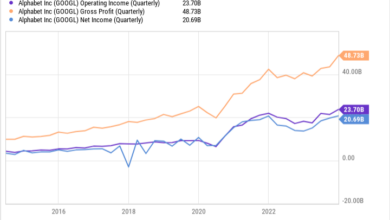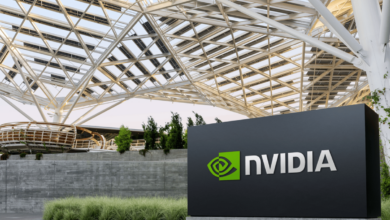3 Dangerous Myths About Nvidia Stock

Nvidia (NASDAQ: NVDA) needs little introduction at this point. The GPU maker dominates the artificial intelligence (AI) era. It’s become the third-most-valuable company in the world behind only Microsoft and Apple, and its revenue more than tripled in its most recent quarter, driving even faster growth on the bottom line.
Nvidia stock jumped more than 500% since the start of 2023. But with its gains accelerating in the first few months of 2024, a new narrative has emerged around the stock, and with it, some pernicious myths. Some investors now believe the stock is in a bubble that will soon collapse, believing that the stock has run too high, too fast and that its profits aren’t sustainable.
However, many of the arguments that form that thesis fall apart upon closer examination. Keep reading to see three such talking points that investors should be skeptical of.

1. Nvidia is like Cisco in 2000
There’s been no shortage of comparisons between the AI boom and the dot-com bubble of the 1990s, and many tech CEOs have likened the disruptive potential of AI to the early days of the internet. Of the famous busts from that era, Cisco Systems sticks out as an analogue for Nvidia. Like Nvidia, Cisco was seen as the picks-and-shovels play of that period, selling routers and switches that were essential for internet connectivity.
However, there seem to be more differences than similarities between Nvidia now and Cisco then. Nvidia’s competitive advantages are more entrenched than Cisco’s were, and it’s been building its empire for far longer. Nvidia invented the GPU in 1999 and has been far and away the leader in the category since. It’s also built an ecosystem to complement its GPU hardware family, which centers around CUDA (Compute Unified Device Architecture), a parallel computing platform it created in 2006 that enables general-purpose computing on Nvidia’s GPUs. CUDA essentially functions as a software layer on top of its hardware. While Cisco was just a seller of hardware, Nvidia is selling an entire tech ecosystem.
Nvidia is also growing much faster than Cisco ever was during the dot-com boom. In fact, Cisco’s earnings per share only increased 140% total from 1996 to 2000, about 25% annually, rising from $0.15 to $0.36 due in part to excessive share-based compensation. Additionally, Cisco’s margins actually declined during that period.
Nvidia, on the other hand, reported a 588% increase in generally accepted accounting principles (GAAP) earnings per share in fiscal 2024, outpacing the stock’s gains; its margins exploded, and its share count fell over the year.
Overall, Nvidia is a much stronger company than Cisco was during the dot-com boom, and Nvidia stock hasn’t gained nearly as much as Cisco did.
2. Competition will erase Nvidia’s AI leadership
Another core tenet of the Nvidia bear thesis is that competition will level the playing field in AI. While it’s true that AI GPU competition is already arriving in the form of products like Advanced Micro Devices‘ MI300 and Intel‘s Gaudi3, AI components are not a commodity product, and this won’t be a race to the bottom.
Because of assets like CUDA and libraries of prebuilt code on its Superchips, Nvidia’s product line is more than just hardware. Those components effectively lock in vendors and provide a suite of tools for customers that is difficult for competitors to match.
While competing products are likely to alleviate the current shortage of GPUs and could weigh on Nvidia’s pricing, investors should also remember that the AI market continues to expand and there are new frontiers for Nvidia to penetrate.
For example, the company launched an AI PC chip in January, opening up a market that it previously hadn’t contested. If Nvidia bears believe AMD and Intel will swipe market share in data center GPUs, which Nvidia currently dominates, they should also consider the prospects of Nvidia turning the tables on its rivals in PCs, their traditional bastion.
Meanwhile, the market for edge computing AI chips, meaning in end-user devices, is also up for grabs, giving Nvidia a key growth opportunity there as well.
Competition is coming, but Nvidia’s competitive moat is formidable, and it can penetrate new AI markets as well.
3. Nvidia is overvalued
In order for Nvidia stock to be in a bubble, it has to be overvalued. By definition, a bubble means that the price of an asset has risen unsustainably because of momentum rather than fundamentals.
Nvidia’s fundamentals, on the other hand, look rock-solid. As noted above, the company’s GAAP profits jumped by nearly 7 times last year, and Wall Street consistently underestimated the company’s growth along the way.
Its valuation also doesn’t seem irrational. The stock trades at a trailing price-to-earnings ratio of around 75, and analysts expect earnings per share to nearly double this year, giving it a forward P/E of less than 40. Nvidia could easily top that forecast as well.
Based on the company’s expected growth rate and its manifest competitive advantages, that valuation seems reasonable. While the stock would certainly fall if it missed estimates, a full-on collapse based on those ratios seems unlikely.
Is it safe to buy Nvidia stock?
There’s still a lot of uncertainty in the developing AI market, but there’s also huge potential growth even for market leaders like Nvidia.
Nvidia stock has been on fire in recent months, and the stock could certainly undergo a significant correction if its results disappoint or the AI revolution doesn’t live up to expectations.
However, based on its current valuation, the competitive landscape, and the strength of the business, the stock is considerably safer than the naysayers claim, and over the long term, Nvidia’s prospects continue to look bright as AI applications proliferate to areas like autonomous vehicles. And Nvidia’s chips are likely to play a role in emerging technologies.
While it’s difficult to predict the short-term movements of any stock, Nvidia still looks like a long-term winner despite claims of an AI stock bubble.
Should you invest $1,000 in Nvidia right now?
Before you buy stock in Nvidia, consider this:
The Motley Fool Stock Advisor analyst team just identified what they believe are the 10 best stocks for investors to buy now… and Nvidia wasn’t one of them. The 10 stocks that made the cut could produce monster returns in the coming years.
Stock Advisor provides investors with an easy-to-follow blueprint for success, including guidance on building a portfolio, regular updates from analysts, and two new stock picks each month. The Stock Advisor service has more than tripled the return of S&P 500 since 2002*.
*Stock Advisor returns as of March 21, 2024
Jeremy Bowman has no position in any of the stocks mentioned. The Motley Fool has positions in and recommends Advanced Micro Devices, Apple, Cisco Systems, Microsoft, and Nvidia. The Motley Fool recommends Intel and recommends the following options: long January 2023 $57.50 calls on Intel, long January 2025 $45 calls on Intel, long January 2026 $395 calls on Microsoft, short January 2026 $405 calls on Microsoft, and short May 2024 $47 calls on Intel. The Motley Fool has a disclosure policy.
3 Dangerous Myths About Nvidia Stock was originally published by The Motley Fool
Source link




